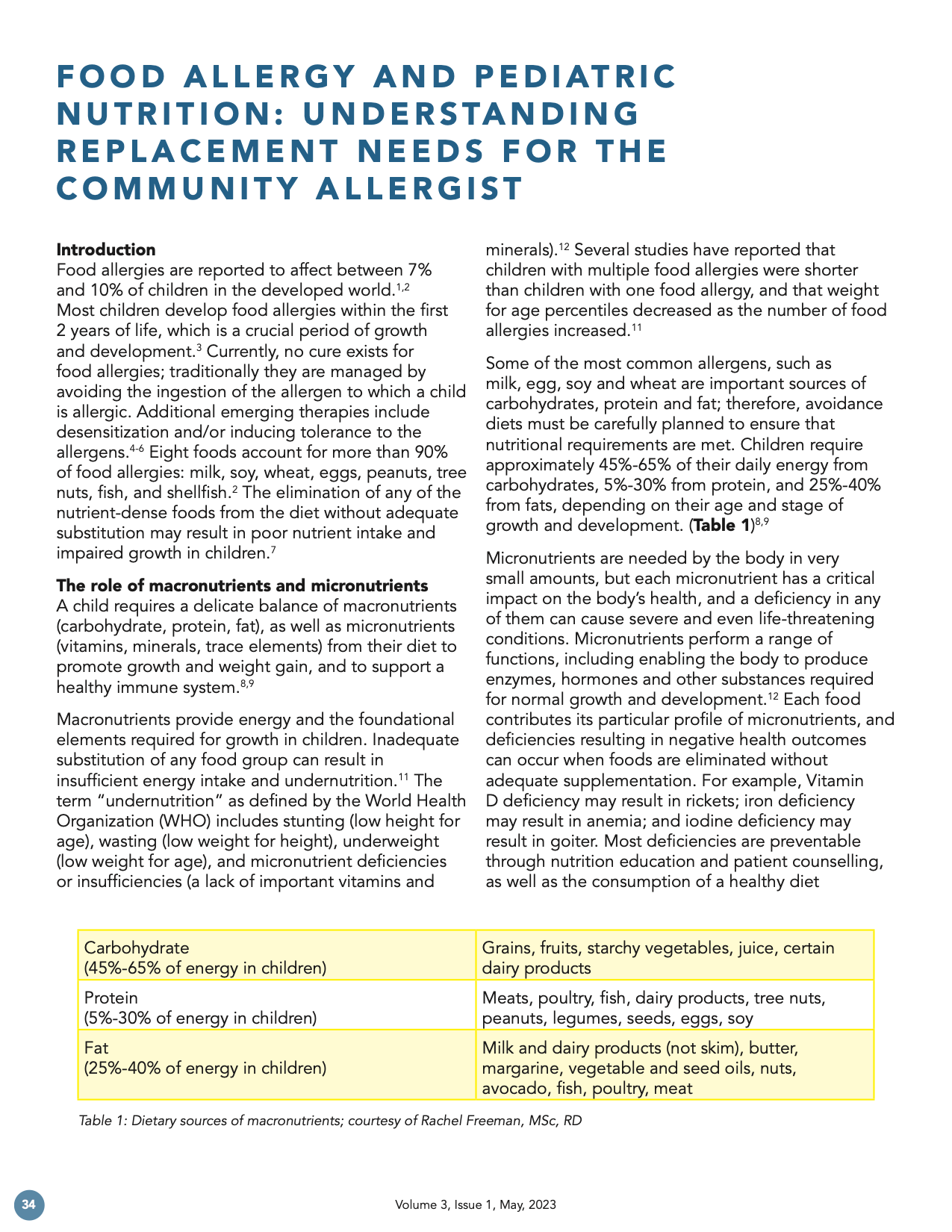Food Allergy and Pediatric Nutrition: Understanding Replacement Needs for the Community Allergist
DOI:
https://doi.org/10.58931/cait.2023.3141Abstract
Food allergies are reported to affect between 7% and 10% of children in the developed world. Most children develop food allergies within the first 2 years of life, which is a crucial period of growthand development. Currently, no cure exists for food allergies; traditionally they are managed by avoiding the ingestion of the allergen to which a child is allergic. Additional emerging therapies include desensitization and/or inducing tolerance to the allergens. Eight foods account for more than 90% of food allergies: milk, soy, wheat, eggs, peanuts, tree nuts, fish, and shellfish. The elimination of any of the nutrient-dense foods from the diet without adequate substitution may result in poor nutrient intake and impaired growth in children.
References
Fleischer D, Chan E, Venter C, et al. A consensus approach to the primary prevention of food allergy through nutrition: Guidance from the American Academy of Allergy, Asthma, and Immunology; American College of Allergy, Asthma and Immunology; and the Canadian Society for Allergy and Clinical Immunology. J Allergy Clin Immunol: In Pract. 2021 Jan;9(1):22-43.e4. doi:10.1016/j.jaip.2020.11.002
Loh W, Tang M. The epidemiology of food allergy in the global context. Int J Environ Res and Pub Health. 2018;15(9):2043.
Mehta H, Groetch M, Wang J. Growth and nutritional concerns in children withfood allergy. Curr Opin All Clin Immun. 2013;13(3):275-279.
Gunaydin N, Azarsiz E, Susler S, et al. Immunologic changes during desensitization with cow’s milk: How it differs from natural tolerance. Ann Allergy, Asthma Immun. 2022 Jul 30 [online].
Heine R. Food allergy prevention and treatment by targeted nutrition. Ann Nutri Metab. 2018;72(Suppl 3):33-45.
Groetch M, Nowak-Wegrzyn A. Practical approach to nutrition and dietary intervention in pediatric food allergy. Ped Allerg Immunol. 2013;24:212-221.
Sova C, Feuling MB, Baumler M, et al. Systematic review of nutrient intake and growth in children with multiple IgE-mediated food allergies. Nutri Cli Pract. 2013;28(6):669-675.
Canada H. Dietary Reference Intakes Tables - Canada.ca. Published 2010. https://www.canada.ca/en/health-canada/services/food-nutrition/healthy-eating/dietary-reference-intakes/tables.html
Canada H. Nutrition for Healthy Term Infants: Recommendations from Six to 24 Months - Canada.ca. Canada.ca. Published 2014. https://www.canada.ca/en/health-canada/services/canada-food-guide/resources/infant-feeding/nutrition-
healthy-term-infants-recommendations-birth-six-months/6-24-months.html
World Health Organization (WHO) Fact Sheet. https://www.who.int/news-room/fact-sheets/detail/healthy-diet. Accessed February 17, 2023.
Mehta H, Ramesh M, Feuille E, Groetch M, Wang J. Growth comparison in children with and without food allergies in 2 different demographic populations J Ped. 2014;165:842-848.
Malnutrition. www.who.int. https://www.who.int/news-room/questions-and-answers/item/malnutrition
Venter C, Mazzocchi A, Maslin K, Agostoni C. Impact of elimination diets on nutrition and growth in children with multiple food allergies. Curr Opin Allerg Clin Immunol. 2017;17(3):220-226.
Hobbs CB, Skinner AC, Burks AW, Vickery BP. Food Allergies affect growth in children. J Allerg Clin Immunol: In practice. 2015;3(1):133-134.e1.
Roesler TA. Factitious Food allergy and failure to thrive. Arch Ped Adolesc Med. 1994;148(11):1150.
Papapostolou N, Xepapadaki P, Gregoriou S, Makris M. Atopic dermatitis andfood allergy: A complex interplay- What we know and what we would like to learn. J Clin Med. 2022;11(14).
Ercan N, Tel Adıgüzel K. Effect of early childhood cow’s milk elimination diet on eating behaviours, nutrition and growth status at age 2-6 years. J Hum Nutri Diet. 2022 Apr;35(2):300-309. doi:10.1111/jhn.12914
Meyer R, Wright K, Vieira MC, et al. International survey on growth indices and impacting factors in children with food allergies. J Hum Nutri Diet.2018;32(2):175-184.
Christie L, Hine RJ, Parker JG, Burks W. Food allergies in children affect nutrient intake and growth. J Am Diet Assoc. 2002;102(11):1648-1651.
Wu YP, Franciosi JP, Rothenberg ME, Hommel KA. Behavioral feeding problems and parenting stress in eosinophilic gastrointestinal disorders in children. Ped Aller Immunol. 2012;23(8):730-735.
D’Auria E, Pendezza E, Leone A, et al. Nutrient intake in school-aged children with food allergies: a case-control study. Int J Food Sci Nutr. 2022 May;73(3):349-356. doi:10.1080/09637486.2021.1975658
Berry MJ, Adams J, Voutilainen H, Feustel PJ, Celestin J, Järvinen KM. Impact of elimination diets on growth and nutritional status in children with multiple food allergies. Ped Allerg Immunol. 2015;26(2):133-138.
Durban R, Groetch M, Meyer R, et al. Dietary management of food allergy. Immunol Allerg Clinics of North America. 2021;41(2):233-270.
Find a Dietitian. Dietitians.ca. Published 2022. https://members.dietitians.ca/DCMember/s/fnd-dietitian?language=en_US.

